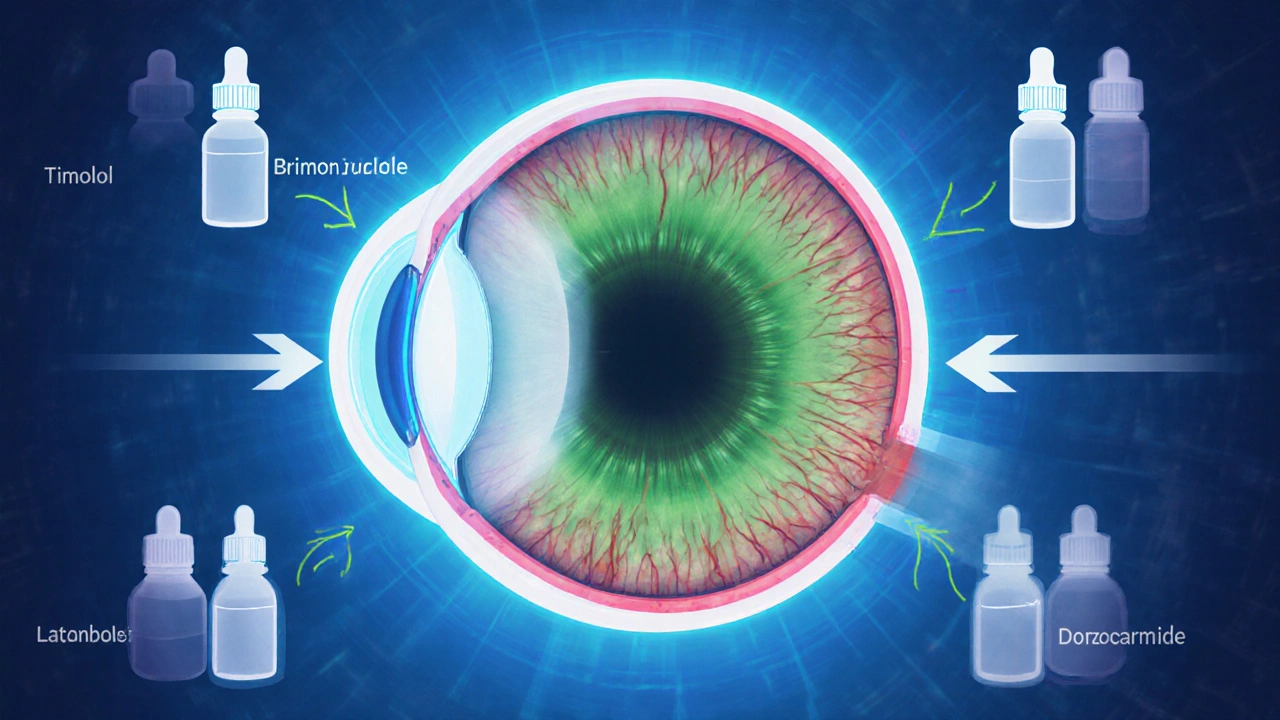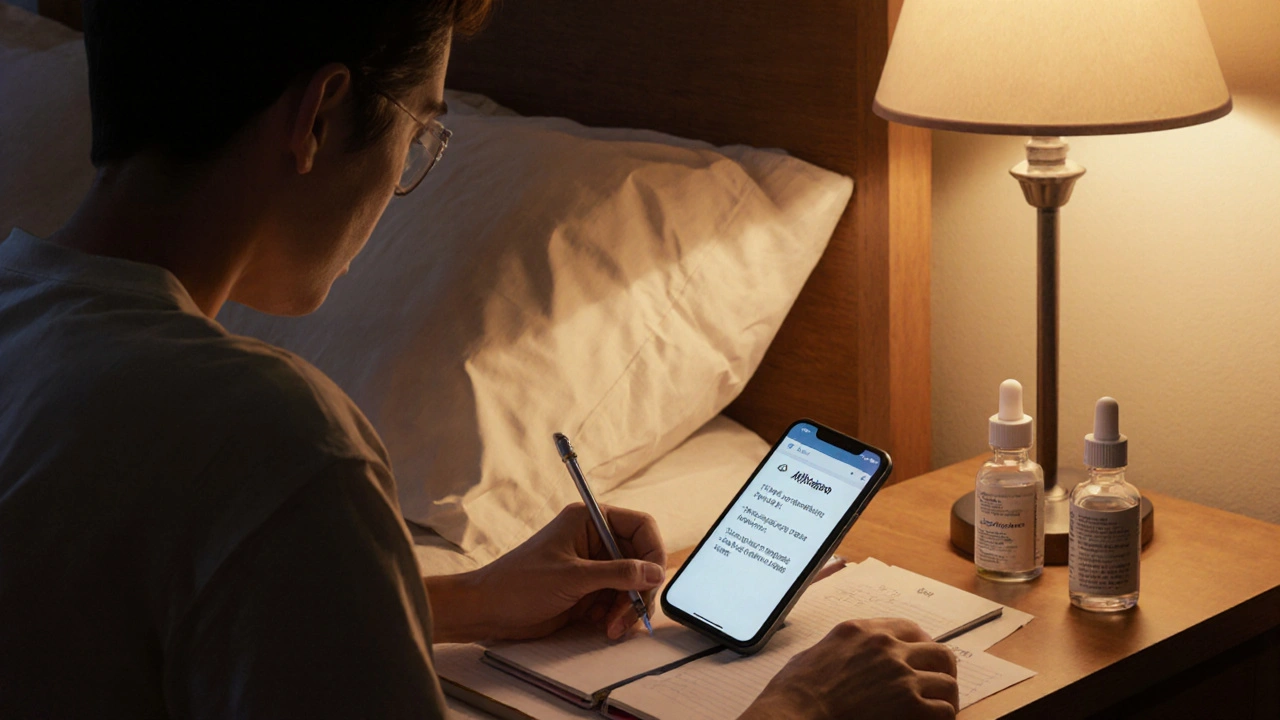Glaucoma Eye Drop Comparison Tool
When your eye doctor mentions that your intraocular pressure (IOP) is creeping up, the first question is usually: which drop should I use? Alphagan is a popular choice, but it isn’t the only game in town. This guide breaks down what Alphagan does, how it stacks up against the most common alternatives, and which factors should guide your decision.
What is Alphagan?
Alphagan is a prescription eye‑drop containing brimonidine tartrate, an alpha‑2 adrenergic agonist that lowers eye pressure. It was first approved in the early 2000s and is marketed for the treatment of open‑angle glaucoma and ocular hypertension. The drug works by both reducing the production of aqueous humor and increasing its outflow, giving a dual‑action effect that many clinicians appreciate.
How does Brimonidine work?
Brimonidine binds to alpha‑2 receptors in the ciliary body, the part of the eye that makes fluid. By activating these receptors, it tells the body to make less fluid while also relaxing the trabecular meshwork, which lets fluid drain faster. The net result is a typical IOP drop of 20‑30% after a few weeks of consistent use.
Top alternatives to Alphagan
Before diving into numbers, let’s meet the main contenders you’ll hear about in clinics across the UK.
- Timolol - a non‑selective beta‑blocker that cuts fluid production. It’s been a first‑line drug for decades.
- Latanoprost - a prostaglandin analogue that primarily increases outflow through the uveoscleral pathway.
- Dorzolamide - a carbonic anhydrase inhibitor that reduces fluid creation inside the eye.
- Pilocarpine - a cholinergic agent that tightens the sphincter muscle, opening the drainage angle.
Each of these drops targets IOP differently, which means side‑effects, dosing schedules, and suitability vary widely.

Comparison table: Efficacy, dosing, side‑effects and cost
| Drug | Typical IOP reduction (% after 4‑6 weeks) |
Dosing frequency | Common side‑effects | Contra‑indications | Average monthly cost (GBP) |
|---|---|---|---|---|---|
| Alphagan | 20‑30% | Twice daily | Dry eye, fatigue, mild allergy‑type redness | Severe cardiovascular disease, asthma | £45‑£55 |
| Timolol | 25‑35% | Once daily | Bradycardia, bronchospasm, cold hands/feet | Heart block, COPD, asthma | £30‑£40 |
| Latanoprost | 30‑35% | Once nightly | Darkening of iris, eyelash growth, ocular irritation | Active ocular infection, recent eye surgery | £35‑£45 |
| Dorzolamide | 15‑25% | Twice daily | Bitter taste, metallic taste, eye stinging | Severe sulfa allergy | £25‑£35 |
| Pilocarpine | 10‑20% | Four times daily | Blurred vision, brow ache, retinal detachment risk (rare) | Inflammatory eye disease, narrow angle glaucoma | £20‑£30 |
When is Alphagan the better choice?
If you need a drug that works both ways-cutting production and boosting outflow-Alphagan is a solid pick. It shines in patients who haven’t reached target IOP with a single‑mechanism agent. For example, a 62‑year‑old with mild cardiovascular disease may find the twice‑daily dose manageable, while avoiding the systemic beta‑blockade of Timolol.
Another niche is ocular hypertension without full‑blown glaucoma. Alphagan’s modest side‑effect profile (dry eye and transient fatigue) is often better tolerated than the darkening of iris seen with prostaglandin analogues, which some patients find cosmetically unsettling.
Scenarios where an alternative may win
Consider a patient with asthma. Timolol’s beta‑blockade could trigger bronchospasm, making Alphagan or a prostaglandin analogue safer. Conversely, if adherence is a problem, a once‑daily night‑time drop like Latanoprost reduces the pill‑burden dramatically, even though it works via a single pathway.
For those who experience significant ocular surface dryness, Dorzolamide’s bitter taste might be a deal‑breaker, whereas the mild dryness from Alphagan could be mitigated with artificial tears.
Cost considerations in the UK
Prescription charges in England remain £9.35 per item, but many patients qualify for free prescriptions under the NHS pre‑payment certificate or exemptions. When you factor in the NHS’s drug tariff, the monthly cost differences narrow: Alphagan (£45‑£55) versus Latanoprost (£35‑£45) versus Timolol (£30‑£40). If you’re on a tight budget, Dorzolamide or Pilocarpine can be cheaper, but remember to weigh efficacy and side‑effects.

Practical tips for switching between drops
- Schedule the switch on a day you can monitor IOP closely (usually the same day you get a follow‑up appointment).
- Start the new drop while tapering the old one, unless the physician advises a wash‑out period-this avoids a sudden IOP spike.
- Maintain a log of any new sensations: stinging, blurred vision, systemic symptoms.
- If you notice a rise in pressure within two weeks, contact your eye clinic immediately; dosage adjustments may be needed.
- Always store drops at room temperature, away from direct sunlight, and discard any bottle past its expiry date.
These steps help you stay in control and give your eye care team the data they need to fine‑tune treatment.
Common pitfalls and how to avoid them
- Skipping doses: Because Alphagan requires twice‑daily dosing, missing a dose can reduce efficacy. Set phone reminders.
- Mixing drops incorrectly: Wait at least five minutes between different eye drops to prevent dilution.
- Ignoring systemic symptoms: Fatigue or lowered heart rate may hint at systemic absorption; report these promptly.
- Using expired medication: The preservative system can break down, causing eye irritation.
Key takeaways
- Alphagan offers dual‑action IOP reduction (20‑30%) with a twice‑daily schedule.
- Timolol and Latanoprost typically provide slightly higher pressure drops but differ in dosing and side‑effects.
- Choose based on comorbidities (e.g., asthma, cardiovascular disease), adherence potential, and cosmetic concerns.
- Cost differences are modest in the NHS; consider prescription exemptions.
- Follow a structured switch plan and keep a symptom diary for optimal outcomes.
Frequently Asked Questions
Can I use Alphagan if I have asthma?
Alphagan is generally safer than beta‑blockers like Timolol for asthmatic patients because it does not block beta receptors. However, discuss any history of respiratory issues with your ophthalmologist before starting.
How long does it take to see the full effect of Alphagan?
Most patients reach a stable IOP reduction within 4‑6 weeks of consistent twice‑daily use. Your doctor will likely schedule a follow‑up appointment around that time to verify the response.
Is it okay to use Alphagan with other glaucoma drops?
Yes, many clinicians combine Alphagan with a prostaglandin analogue or a carbonic anhydrase inhibitor to achieve greater pressure control. Space the drops by at least five minutes and follow your eye‑care professional’s instructions.
What should I do if I experience severe eye redness after starting Alphagan?
Mild redness is common, but if it becomes intense, worsening vision, or is accompanied by pain, stop the drops and contact your ophthalmology clinic right away. You may need an alternative medication.
Can I switch from Timolol to Alphagan without a wash‑out period?
Usually, a direct switch is fine because the mechanisms differ. Your doctor may advise a brief overlap or a short pause to monitor IOP, especially if your pressure is borderline.

Anthony Coppedge
October 8, 2025 AT 13:30
Alphagan’s dual‑action mechanism, which both curtails aqueous humor production and facilitates outflow, offers a balanced approach to IOP reduction; this is particularly valuable for patients who have not achieved target pressures with monotherapy. Moreover, the twice‑daily dosing schedule, while requiring adherence, ensures more stable drug levels throughout the day; however, patients must be diligent about timing. Side‑effects such as mild dry eye and transient fatigue are generally manageable with artificial tears or dose timing adjustments. In terms of cost, the NHS tariff mitigates the price gap between Alphagan and prostaglandin analogues, making it a viable option for many. Ultimately, the choice should align with individual comorbidities and lifestyle preferences.
Joshua Logronio
October 17, 2025 AT 19:43
Alphagan is cool.
Nicholas Blackburn
October 27, 2025 AT 01:57
Let’s get one thing straight: the author’s hodgepodge of tables and marketing fluff does not substitute for a rigorous clinical appraisal. First, the claim that Alphagan “offers dual‑action” is technically correct, but the author conveniently ignores the fact that dual‑action does not guarantee superior efficacy; the data still shows a modest 20‑30% IOP drop, which is eclipsed by prostaglandin analogues reaching up to 35% in comparable trials. Second, the side‑effect profile is down‑played; dry eye and fatigue may sound trivial, yet they contribute to non‑adherence, especially in elderly patients who already struggle with polypharmacy. Third, the cost comparison is misleading – the quoted £45‑£55 per month ignores the extra dispensing fees and the fact that many patients qualify for free prescriptions, nullifying the perceived price gap. Fourth, the author fails to address the systemic absorption of brimonidine, which can cause hypotension and bradycardia in susceptible individuals, a point that is conspicuously absent from the safety section. Fifth, the recommendation algorithm that simply avoids “bronchospasm” when asthma is mentioned is a brittle heuristic; it bypasses the nuance of dose titration and patient monitoring. Sixth, the dosing frequency (twice daily) is presented as neutral, but in reality it reduces real‑world adherence compared to once‑daily regimens like latanoprost, which have demonstrably better persistence rates. Seventh, the table format gives the illusion of objectivity, yet the “Typical IOP reduction” rows are derived from heterogeneous studies without standardization of baseline pressures. Eighth, there is no discussion of the potential for ocular surface disease exacerbated by chronic preservative exposure, a major concern for dry‑eye sufferers. Ninth, the article glosses over the fact that combination therapy (e.g., Alphagan plus a carbonic anhydrase inhibitor) is often required, which adds complexity and cost. Tenth, the author’s tone remains overly optimistic, bordering on promotional, and neglects the ethical responsibility to present balanced risk‑benefit analyses. Eleventh, the “practical tips for switching” are generic and do not address the need for wash‑out periods in cases of overlapping mechanisms. Twelfth, the suggestion to log symptoms is useful but lacks guidance on what constitutes a red‑flag warranting immediate medical attention. Thirteenth, the piece does not cite any recent meta‑analyses that could validate its claims. Fourteenth, the lack of patient‑centered outcomes (quality of life, visual function) reduces the relevance of the comparison. Fifteenth, overall, the article feels like a repackaged pharmaceutical brochure masquerading as an evidence‑based guide, and readers should approach it with healthy skepticism.
Dave Barnes
November 5, 2025 AT 08:10
When we consider the philosophy of ocular therapeutics, we must ask whether a drug's elegance lies in its mechanistic breadth or its simplicity. Alphagan’s dual‑action is conceptually attractive, yet the universe of glaucoma care rewards adherence above all else. A medication that demands two daily instillations may invoke the classic paradox: complexity promises control, but simplicity ensures persistence. Perhaps the real wisdom is to match patient lifestyle with pharmacologic design, rather than chasing the most sophisticated molecule.
Kai Röder
November 14, 2025 AT 14:23
Thank you for highlighting that balance. In practice, we see many patients who thrive on a once‑daily prostaglandin precisely because it fits into their routine without the need for conscious reminders. While Alphagan’s dual mechanisms are scientifically sound, the added dosing step can be a barrier for those with busy schedules. Encouraging clinicians to individualize therapy-considering both efficacy data and real‑world adherence-remains the most inclusive approach.
Brandi Thompson
November 23, 2025 AT 20:37
Reading through the comparison feels like wading through a sea of numbers and buzzwords without a clear navigational compass; the author lumps together efficacy percentages, dosing frequencies, and side‑effect spectrums, but never ties them back to patient‑centered outcomes or quality‑of‑life measures which are ultimately what matter the most in chronic disease management the cost discussion, while present, is presented in a way that assumes every reader has the same insurance coverage or NHS eligibility which is simply not the case it's also worth noting that the side‑effect profiles listed are not exhaustive many patients experience nuanced symptoms like intermittent eyelid swelling or subtle visual disturbances that aren't captured in the blunt bullet lists so while the table is a helpful starting point for clinicians it should be supplemented with individualized counseling and periodic reassessment to truly optimize therapy
Chip Hutchison
December 3, 2025 AT 02:50
I appreciate the thoroughness of the table and the reminder to individualize care. It’s crucial that we don’t let the data become a one‑size‑fits‑all prescription. By checking in with patients about their daily routines, ocular comfort, and any systemic concerns, we can better decide whether Alphagan’s twice‑daily schedule or a once‑daily prostaglandin best aligns with their lives. Open dialogue and regular monitoring are the keys to long‑term success.